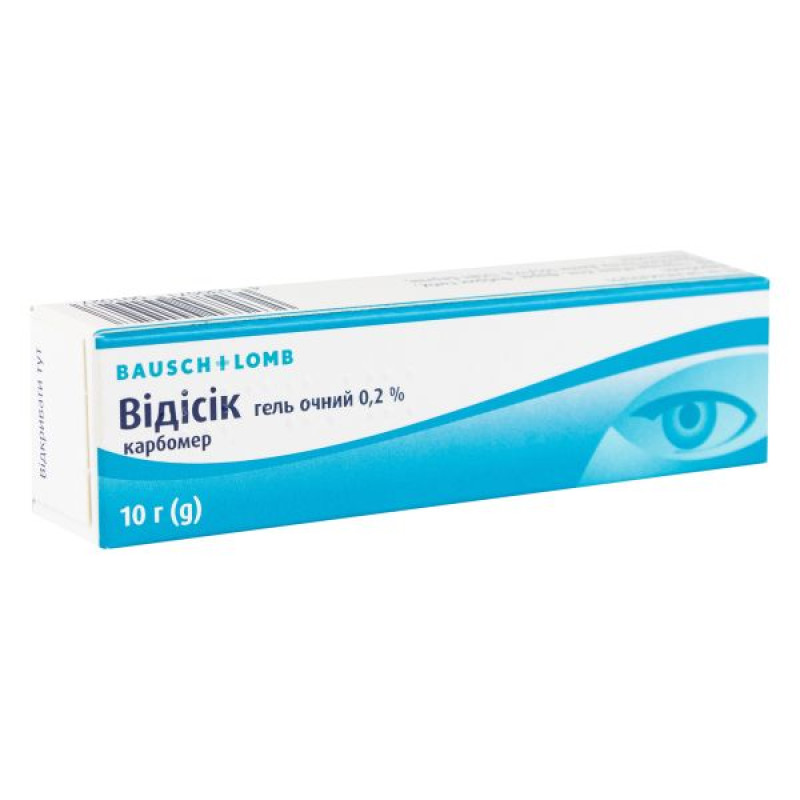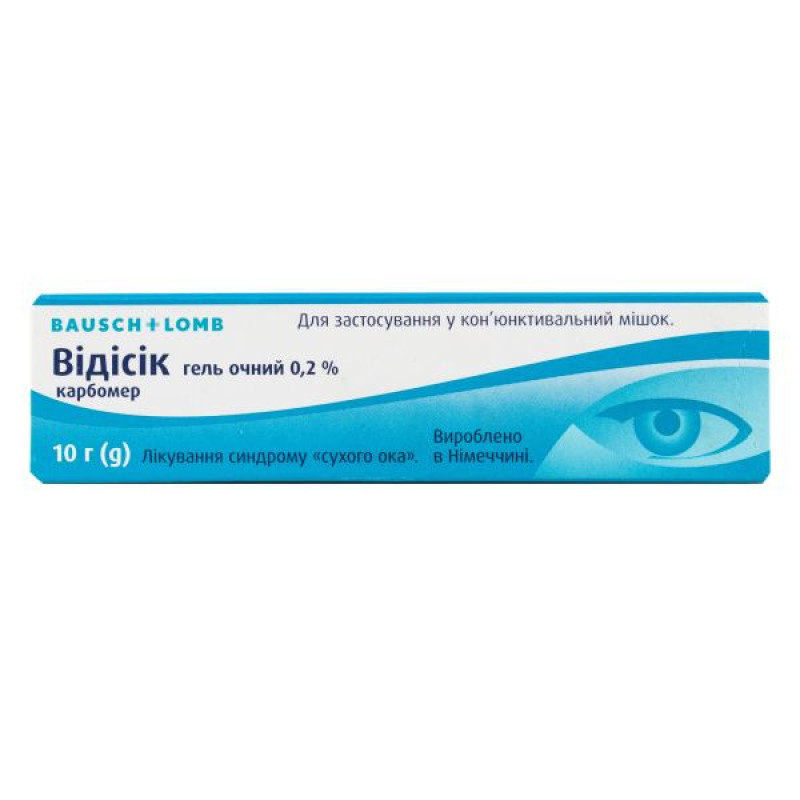Vidisik eye gel 0.2% tube 10 g

Instructions for Vidisik eye gel 0.2% tube 10 g
Composition
active ingredient: carbomer;
1 g of eye gel contains 2 mg of carbomer;
Excipients: cetrimide, sodium hydroxide, sorbitol (E 420), water for injections.
Dosage form
Eye gel.
Main physicochemical properties: transparent, colorless gel, viscosity of which is 4300-6300 mPa·s
Pharmacotherapeutic group
Artificial tear fluid substitutes and other neutral preparations. ATS code S01X A20.
Pharmacological properties
Pharmacodynamics
The basis of the drug is a high-molecular hydrophilic polymer, the pH value and osmolality of which are similar to the physiological tear film. Due to its physical properties, the eye gel retains water and forms a transparent and moist film on the surface of the eye.
Pharmacokinetics
In pharmacokinetic studies, radioactive carbomer was administered to rats. The results of the studies showed that only a small amount of carbomer was absorbed. After a single administration, it was found that 0.75% of the dose was excreted during respiration as carbon dioxide and 0.63% was excreted in the urine. The bulk of carbomer (92%) was excreted in the feces within 24 hours after administration. Given the macromolecular nature of carbomer, it can be predicted that it is excreted from the body without undergoing metabolic transformations, i.e., does not undergo hepatic cycling.
The maximum residence time of carbomer on the surface of the eye is about 90 minutes.
Indication
Replacement therapy for reduced tear secretion, treatment of dry eye syndrome, symptomatic treatment of keratoconjunctivitis sicca.
Contraindication
Hypersensitivity to any of the components of the drug.
Interaction with other medicinal products and other types of interactions
Unknown.
Vidisik may prolong the contact time of other medications used with the eyes. When using Vidisik simultaneously with other eye drops, there should be an interval of at least 5 minutes between the administration of the drugs. If Vidisik is used together with other topical eye medications, including eye ointments, there should be an interval of at least 15 minutes between the administration of the drugs. In any case, Vidisik should be instilled last.
Use during pregnancy or breastfeeding
There are no clinical data on the safety of Vidisik during pregnancy and breastfeeding. Preclinical studies of the drug indicate that the risk of using Vidisik during these periods is very low.
Use during pregnancy or breastfeeding is possible only on the recommendation of a doctor, if the expected benefit from using the drug outweighs the potential risk.
The ability to influence the reaction speed when driving or working with other mechanisms
Blurred vision may occur for a few minutes after instillation of Vidisik into the conjunctival sac. Therefore, it is recommended to refrain from driving or operating machinery until vision is clear.
Method of administration and doses.
Treatment of dry eye requires an individualized dosage regimen. Depending on the severity and intensity of symptoms, apply one drop into the conjunctival sac 3-5 times daily or more frequently, and approximately 30 minutes before bedtime.
When using Vidisik for the treatment of keratoconjunctivitis sicca, an ophthalmologist should be consulted, as this disease usually requires long-term or permanent treatment.
Children
There is no data on the safety of the drug for the treatment of children, therefore the drug is not recommended for use in this category of patients.
Overdose
Unknown.
Adverse reactions
Immediately after administration of the drug, temporary blurred vision may occur.
In rare cases, hypersensitivity reactions to some components of the drug, eye pain, may occur.
Vidisik contains the preservative cetrimide, which may cause eye irritation, especially with frequent or prolonged use (burning, redness, foreign body sensation in the eye, tingling sensation) and damage to the corneal epithelium. Therefore, for the treatment of chronic keratoconjunctivitis sicca, preservative-free preparations should be used.
Expiration date
3 years.
After the first opening of the tube, its contents are suitable for use for 6 weeks.
Storage conditions
Store out of the reach of children at a temperature not exceeding 25 °C.
Packaging
10 g of gel in a tube with a tip and a screw cap.
One tube with instructions in a cardboard box with labeling in Ukrainian.
Vacation category
Without a prescription.
Manufacturer/Applicant
Dr. Gerhard Mann Chem.-pharm. Fabric GmbH, Germany/Dr. Gerhard Mann Сhem.-pharm. Fabric GmbH, Germany.
Location of the manufacturer and its address of place of business/location of the applicant and/or representative of the applicant.
Brunsbütteler Damm 165-173 13581 Berlin, Germany/Brunsbuetteler Damm 165-173 13581 Berlin, Germany.
There are no reviews for this product.
There are no reviews for this product, be the first to leave your review.
No questions about this product, be the first and ask your question.








